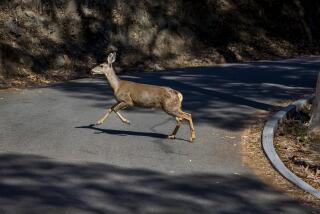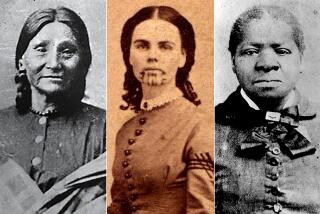Book review: ‘Fur, Fortune, and Empire’
Fur, Fortune, and Empire
The Epic History of the Fur Trade in America
Eric Jay Dolin
W.W. Norton, 444 pp., $29.95
In “Company of Adventurers,” the first of a three-part history of the Hudson’s Bay Co., Peter C. Newman wrote: “Seldom has an animal exercised such a profound influence on the history of a country. Men defied oceans and hacked their way across North America; armies and navies clashed under the polar moon; an Indian civilization was debauched — all in quest of the pug-nosed rodent with the lustrous fur.”
The hunt for the lowly beaver almost inadvertently “turned into the quest for a nation,” Newman wrote, and while his account focuses on Canada, Eric Jay Dolin adapts the argument for its neighbor below the 49th parallel. Though guns, germs and steel certainly played their parts, Dolin’s “Fur, Fortune, and Empire” leaves little doubt that the trade in pelts “was a powerful force in shaping the course of American history from the early 1600s through the late 1800s, playing a major role in the settlement and evolution of the colonies, and in the growth of the United States.”
Dolin puts forth a compelling and well-annotated tale of greed, slaughter and geopolitics as the Dutch, English, French, Spanish, Swedes, Russians and the American colonists fought for a slice of the profit.
By the time Henry Hudson made his exploratory visit to these shores in 1609, French trade with the coastal Indians “was already well established” and was highly envied by the Dutch. (Jacques Cartier traded with Micmacs in what is now New Brunswick in 1534, and the native populace was primed even then, standing onshore waving furs aloft on sticks to entice the Europeans.) The well-known backdrop here is that toward the end of the 16th century, “high quality beaver hats were the most expensive and desired hats not only in England but throughout Europe,” their size and shape highly symbolic of social status. At the same time, the European supply of fur was declining precipitously, which “is why Hudson’s report of furs elicited such excitement in Holland,” Dolin writes.
From the beginning, the Pilgrims were heavily dependent on the fur trade in attempts to reach solvency — they soon expanded their efforts into what is now Maine and Cape Cod — an early surprise in Dolin’s account, unless one has read Gov. William Bradford’s history of Plymouth Plantation or other source documents well-exploited here. To the south, in 1626, the Dutch in New Amsterdam at the mouth of the Hudson River were sending a ship back to the Netherlands bearing 7,246 beaver skins, 853 otter skins, plus a few mink, wildcat and rat skins. Between 15,000 and 20,000 furs, mostly beaver, were shipped from New France to France at the same time. Almost immediately, trading guns to natives emerged as a significant issue, with liquor soon to follow, a “devastating fixture” of the cultural exchange that foreshadowed what took place over the next two centuries. Eastern river valleys — the Connecticut, the Delaware — became contested ground, as those of the Ohio and others would later.
The fur trade, a slave to fashion, had its ups and downs, but it inexorably “swept like a lethal wave over the land,” in Dolin’s words, leaving not just the beaver but also the sea otter and the bison seriously threatened as species. In the early years, “Indians were somewhat amused by the Europeans’ great desire for furs and their willingness to part with valuable trade goods to get them.” By 1664, the English had succeeded in expelling the Dutch, but exploration by René-Robert Cavelier, Sieur de la Salle and others ensured that by the late 1680s, “a nearly 3,000-mile battle line had been drawn from the Gulf of St. Lawrence to the Gulf Coast, with the French and the English on opposite sides.”
As for the future Americans, their share of trade was “moribund on the eve of the Revolution,” collapsed entirely during it, and was retarded in the postwar years when the British dragged their heels in abandoning long-occupied posts. In 1801, however, of 23 trading ships plying the Northwest Coast, 20 were American, a dominance that held into the 1830s. Boston merchants were so numerous that the natives referred to citizens of the United States as “Boston Men,” and the New Englanders developed a global loop, sending trade trinkets to the Northwest, Northwest pelts to China and Chinese goods back to Boston.
In the Northwest and, in particular, the Rocky Mountains, Dolin’s historical reporting is studded with violent incidents and little-remembered names from American history, as small groups of trappers and sailors engaged with bands of Indians, each the leading edge of contact for their respective peoples. Those are among the strongest elements of “Fur, Fortune, and Empire.” Famous mountain men such as Jim Bridger and Jedediah Smith also make appearances, as does necessarily the fur magnate John Jacob Astor, whose “unimaginably lucrative” American Fur Co. and ill-fated West Coast trading post Astoria figure heavily in the book. ( Washington Irving’s “Astoria” is a significant source here and a lively read on its own, although Astor was a good friend of Irving’s and Irving wrote at least part of it while living in Astor’s mansion.)
The Indians were “victims of injustice, cruelty, and oppression, and of a policy that seems to recognize power as the sole standard of right,” recalls one veteran ship captain of the Northwest trade. They were human damage that was hardly collateral to the whole fur enterprise; that desperate situation intensifies once Dolin turns to the fate of the bison.
Numbering 30 million or more at the time of European contact and brought to the edge of extinction, the buffalo, according to observers like the artist George Catlin, would soon meet their end. “The buffalo’s doom is sealed,” he declared in 1841. Given that the American trade in buffalo robes did not take off until after the War of 1812, the pace of killing almost defies comprehension.
The so-called Age of Extermination may have passed, but the global fur trade still falls between $10 billion and $15 billion annually.
For the once trapped-out beaver, however, Dolin reports that the animal was again spotted in 2007 in the Bronx River, the first seen in New York City (formerly New Amsterdam) in about 200 years.
Winslow is a former literary and executive editor of the Nation.
More to Read
The biggest entertainment stories
Get our big stories about Hollywood, film, television, music, arts, culture and more right in your inbox as soon as they publish.
You may occasionally receive promotional content from the Los Angeles Times.










